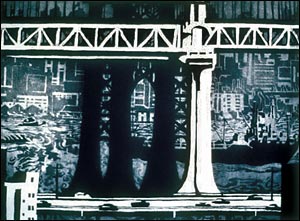 |
 |
The New York Times, Friday, April 25, 1986
"Art: Juried Exhibition at National Academy"
by Michael Brenson

Richard Sloat's etching, "Bridge, Boats, Brooklyn," is
in show at the National Academy of Design
The open juried show at the National Academy of Design, 1083 Fifth Avenue, at 89th Street, has the potential to fill an important need. There are now few juried shows anywhere and probably none in which a broad range of artists can exhibit within a selective, traditional framework. The more the academy opens up this show -- in odd-numbered years, the annual is available to members alone -- the less protected and more dynamic the National Academy will become.
One reason why this year's show -- through May 4 -- has more energy than usual is that the competition in painting, sculpture, graphic art and watercolor was held in SoHo. According to John H. Dobkin, the academy's director, about 1,000 paintings were sumbitted, from which around 100 were chosen. Younger artists brought in work not only from SoHo, but also from the East Village. Perhaps for the first time, a National Academy annual has made room for the warm, lurid palette, gestural brushwork and mass-media subject matter that have been prevalent in downtown galleries.
If this is not an exhibition filled with outstanding works, it does not have to be. What matters more is the vitality resulting from the increased range, and from the show's belief that a commitment to an essentially academic art training does not have to be incompatible with art that may seek to hide evidence of that training, or leave it behind.
In addition, as always, the show provides a forum for less known traditional artists, such as Richard Sloat -- whose etching of "Bridge, Boats, Brooklyn" [pictured at top of article and shown above] uses light and movement to weave together the conflicting energies of New York City.
The show does include what the public would expect from a National Academy annual. There are tacky works. There are plenty of earnest renderings of snowy fields and exotic places. There are also many landscapes, cityscapes and portraits that seek the kind of empathetic understanding with people and things that continues to be far more possible through traditional rather than alternative means.
There are also a number of works of substance by established artists and academy members. The exhibition includes one of Jane Wilson's silvery, turbulent skies and a Lennart Anderson portrait in an American Old Master style. There is also a large Harvey Dinnerstein watercolor of what seems to be an irresistible, curmudgeonly artist wielding his huge paintbrush like a shillelagh.
Some of the other academy members who were willing to risk an open competition include Stephen Greene, Esteban Vicente, Nell Blaine, John Heliker, Jules Kirschenbaum, Louis Finklestein, Gretna Campbell, Ethel Magafan and Charles Cajori. In "City of Dreams," the graphic artist John Ross offers a bridge from a modern metropolis to a futuristic nightmare that seems too short for comfort. Bruno Lucchesi's relief sculpture of a "Women's Rest Room" is a lot lighter, providing an irreverent perspective on a subject from which he certainly does not want to wash his hands.
But the most noteworthy aspect of the show is its willingness to welcome new sources. Hans Feuerhahn's engraving "Cityscape," with its attempt to compress urban violence, indifference, shock and victimization into a graphic image, brings to mind the political art of Sue Coe. John Beerman's "Listen Carefully and You Will Hear," with its sweet colors and florid frame, suggests the imaginary technicolor landscapes of Alan Herman.
Michael Davis's painting "Untitled" is so small and so idiosyncratic that it may be the easiest painting in the show to overlook. It is an intriguing work, however, and it reflects another direction in East Village art -- one seeking to build a maximum of content into a minimal image. The subject of the painting is a snail shell blown up so that it suggests an ear and a skull, and isolated on a yellow-orange ground. The painting itself is snail-like -- slow and quiet, promising accessibility and attentiveness, but also turned in upon itself and offering less an answer than a secret.
About the Artist
Articles & Reviews (main)
Biographical Data
Catalogues & Published Work
Contact Information
Exhibitions & Collections
Home |
 |
 |



